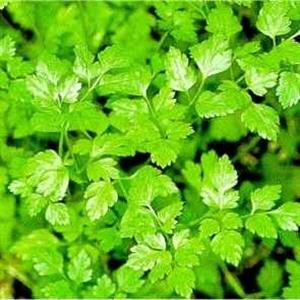
Learning Download: How to Grow Chervil
From Seed to Harvest: A beginner’s guide to growing Chervil.
Chervil, also known as French parsley, is an annual herb that has leaves best used to season mild-flavored dishes. It is a cool-season plant and can reach 2 feet in height. Its leaves are similar to parsley and it grows small white flowers May through July. The leaves have a slight aniseed taste that resemble the look of a fern. Chervil is one of the four herbs that makes up the popular French blend “fine herbs.” It is not easily found in a grocery store, so the best way to obtain the plant for cooking use is by growing it yourself.
To plant:
Chervil should be sown directly outdoors in the spring or fall. If planting in the spring, sow outdoors about two weeks before the last frost. Chervil seeds will not germinate well if they are older than one year. To plant, sow a group of five seeds just below the surface of the soil and space each grouping 12 inches apart. Firmly press on the soil over the seeds and keep the area well-watered.
Chervil is a delicate pant and grows best in partial sun and partial shade. Plant near a sheltered area. Seeds can also be sown every couple of weeks in successive plantings. The chervil plant makes for a great indoor herb, as it is not a fan of hot conditions.
To grow:
When seedlings reach 2 inches tall, thin them to 4 inches. Chervil grows well near carrots and radishes and is said to increase the heat and crispiness of radishes. It also grows well near cilantro and dill, and the three herbs grow great together in containers. If planted near lettuce, it discourages aphids and other pests. Since chervil does not grow well in hot conditions, water the plant consistently. Frequently clip the leaves from the plants to encourage more growth.
To harvest:
Chervil leaves are ready to harvest about six weeks after planting, and gardeners can harvest them as needed. Pick the leaves from the outside of the plant first, as those will have the best flavor. To harvest the leaves, just pinch them off with your fingers. Chervil can tolerate some frost, but once cold weather is consistent, harvest as much chervil as possible before the plant dies. Since chervil is an annual, reseed the plant so it returns the following year. To do so, after harvesting for the season, replant the chervil with seeds from the seed heads after you cleared the dead stalks out of the herb bed.
What chervil craves:
To encourage more leaves, add a nitrogen-rich fertilizer to the chervil plants. Since most herbs don’t require fertilization, take care not to over-fertilize the plants.
Where to buy chervil seeds:
you can find chervil seeds at Urban Farmer.

